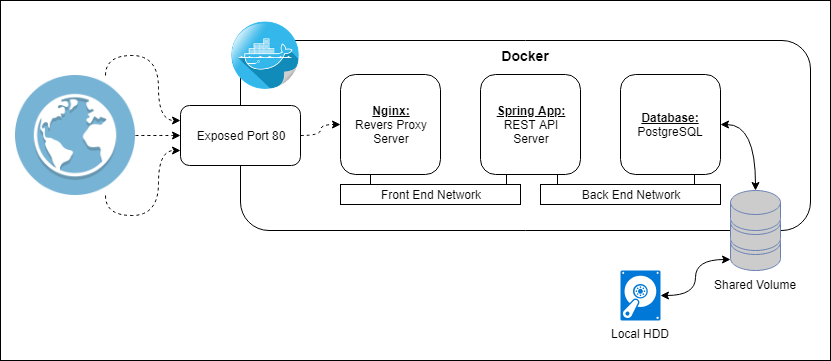This project was designed to be the start base for any Spring Boot project with Dockerized infrastructure,
which would include the following containers:
* Reverse Proxy Server (Nginx)
* Server API (Spring Boot Application)
* Database (PostgreSQL)
Everything is controlled trough docker-compose which automatically manage containers, internal networks and
shared volume for data persistence.
The project support cross-platform build and can be run on Windows / Mac / Linux
Project can be cloned and renamed to match your needs with use of RenameProject.py script.
Here are the steps:
- Clone Project
- Rename project root folder from
SpringProjectBaseto<YourProjectName> - Navigate inside
<YourProjectName>space troughCMD||Terminal - Execute:
It will rename the whole project, all references inside as well as java package name
python RenameProject.py package=com.yourpackage - Import project as
gradleproject in your IDE - Done
The project can be run by calling rebuild_dockers_and_run.[sh || ps] script.
It will compile and re-build everything automatically as well as create docker images and start containers
trough docker-compose
Note for Windows users: To execute PowerShell script on Windows trough CMD it is required to grant permission.
It is single time activity per user, but still required to run in PowerShell:
Set-ExecutionPolicy -ExecutionPolicy RemoteSigned -Scope CurrentUser
This project contains bare minimum of Spring Boot application which would be easy to wipe and continue
with your own project.
Spring App contains the following functionality:
- Application
- Main Application to run
- Simple Controller
- Hello World
- Add Item
- Get Item by ID
- Get All Items
- Health Check
- Database DAO, Model and Service Implementation
- Properties configuration for PostgreSQL
- Pre-populated DB dummy data with DB Schema trough prepared
SQLfiles insrc/main/resources
- Tests
- Tests to test all APIs in controller
- Properties configuration for H2 database
- Pre-populated DB dummy data with DB Schema trough prepared
SQLfiles insrc/test/resources
The project require gradle v4.7 for the build and can be build locally by simply executing gradle build command
However, to be platform independent as well as do not configure and maintain gradle package locally
the project designed to be build with use of docker container.
The Dockerfile located in deployment/build/Dockerfile
For simplicity project contains scrip gradle_build.[sh || ps1] which can be executed as on Windows in PowerShell
as well as on Mac or Linux using bash.
To speedup the build and do not pull gradle dependencies each build it is recommended to mound gradle cache to the
local space.
The Docker command for the build:
docker run -it --rm -v gradle:/home/gradle/.gradle/ -v $(pwd):/opt/SpringProjectBase -e ACTION=build gradle-build
This command mount local gradle volume to container to store persistent all downloaded dependencies
And mount local project to /opt/<YourProjectName> (if you renamed it). Once build is complete it will produce
Build/lib folder with required jar artifact.
Note: that command can be used not only for the gradle build, but also for any other pre-defined gradle
action like gradle test for example. For that just change the value of ACTION environment variable
The Dockerfile is located in deployment/target/Dockerfile. It is based on Alpine OS to reduce size with latest
available for Alpine OpenJDK 1.8
During the build process it execute the following steps:
- Setup Health Check
- Add custom spring user and group (to not run service as a root)
- Copy artifact from
build/libs/*.jar(Note: The Artifact need to be already present from previous stepBuild Artifact) - Change ownership
- Expose 8080 ports (only for internal docker network)
- Run Spring Boot jar (Tomcat is embedded this days, no need to drop *.war's anymore in
webappsfolder)
Docker image can be build manually with:
docker build -t backend_server . -f deployment/target/Dockerfile
But usually this process controlled by docker-compose
Note: If you run container on its own it will more likely to fail dew to missing database.
For simplicity you can run DB in container (see below teh chapter about DB), but don't forgot to expose the ports
to your local machine as well as make record in system hosts file to resolve correctly postgres_db hostname or
update property file for custom connection.
The Dockerfile is located in deployment/db/Dockerfile. It is based on original Postgres Alpine image.
It implements only Health Check, no any other changes.
Note Windows Users: For persistent storage you cannot simply mount a local folder to container, as Postgres
in the docker running in Linux environment and cannot have data to be stored in Windows NTFS.
Therefore to solve this problem create Docker Volume:
docker volume create --name <db_data> -d local
This process is automated in the script rebuild_dockers_and_run.[sh || ps] and if you don't what that
your data is wiped each docker image re-build just comment it out.
Using Nginx Alpine OS as base images to reduce container size as maximum as possible
Dokcerfile and nginx.conf are located in: deployment/proxy/ folder
It implements Health Check and overwrite default Nginx config.
Docker build command:
docker build -t nginx_proxy . -f deployment/proxy/Dockerfile
